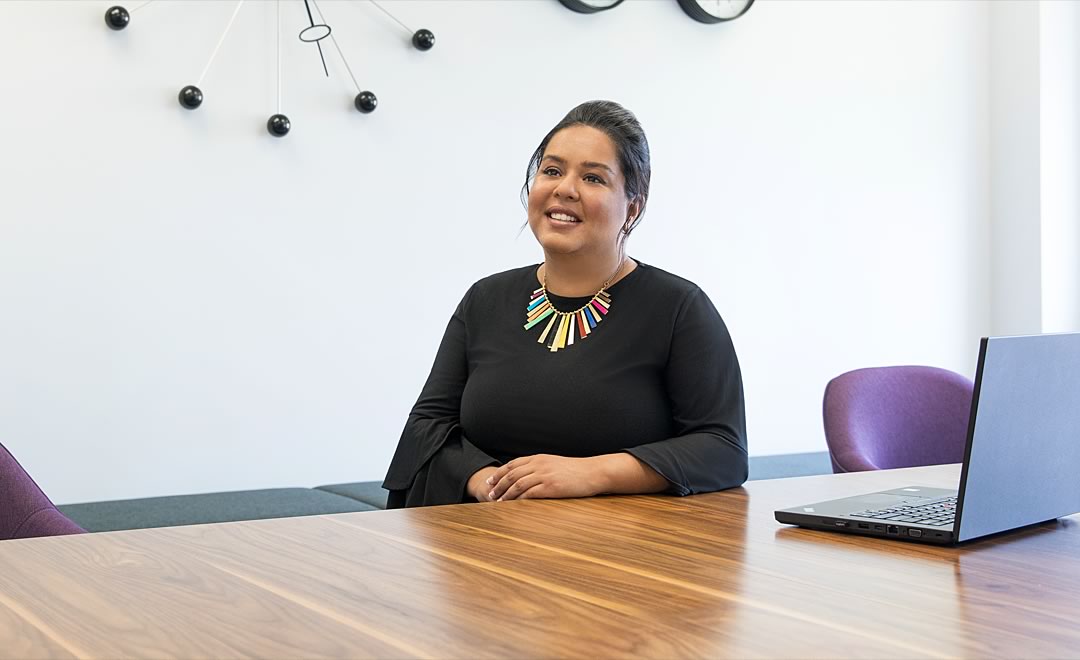
Ishneet Singh: project coordinator, plasma strategy, Canadian Blood Services
I’m proud to be part of creating the first dedicated donor centres in support of our national plasma strategy.”
For Ishneet Singh, ensuring a secure supply of plasma for patients who depend on immune globulin (Ig) is not an abstract challenge — it’s the job she tackles every day.
“The declining plasma supply has been on our radar for a long time,” says Ishneet Singh. “Right now, Canada's sufficiency level is 13.5 per cent. This means that only 13.5 per cent of Canada's need for Ig products is being met with Ig made by manufacturers of pharmaceutical products for Canadian Blood Services from plasma collected by us from volunteer donors in Canada. We meet the rest of the country's Ig needs (85 per cent) by purchasing Ig drugs on the global market. These drugs are made largely by pharmaceutical companies from plasma they collect from paid donors in the U.S. We know we must increase Canada's sufficiency level by collecting more plasma in Canada and reducing our reliance on the U.S market.”
In March 2019, after extensive consultations with Canadian Blood Services provincial and territorial health ministries approved a proof-of-concept program establishing three stand-alone plasma collection sites that will serve as models for a Canada-wide solution. It was a vital step forward after many months of analysis and planning. Now work is well underway to get donor centres up and running in Sudbury, Ontario; Lethbridge, Alberta; and Kelowna, British Columbia — three geographically diverse communities that met our rigorous selection criteria.
The 360-degree view
As the team’s project coordinator, Ishneet helps to organize and advance every aspect of the complex initiative — identifying optimum locations based on current donation patterns; evaluating staffing needs; identifying more efficient processes; developing donor recruitment plans for each potential catchment area; and the list goes on. Then there are the countless practical details of negotiating leases, arranging IT and other infrastructure, and working with designers to create environments that are both efficient and welcoming.
“We face a lot of tight deadlines and logistical challenges,” Ishneet says, “along with the inevitable curveballs you get with any program. Plus, there are people collaborating from many different areas of the organization. This is what keeps my job exciting. You can never focus on just one item. You have to constantly be getting a 360-degree view.”
Applying lessons learned
Ishneet benefits from her previous experience working on the Large-Volume Source Plasma Project, which introduced source plasma donation at mixed-collections sites in London, Ontario, and Calgary, Alberta — and yielded about 37 per cent more plasma per donor visit. By the end of the fiscal year, more than 2,000 litres of additional source plasma had been collected at the two sites for fractionation into Ig and other plasma protein products. It was a modest but important step in leveraging our current network of donor centres to optimize plasma collection.
Armed with key insights from this project, the plasma operations team is consulting with industry experts and other blood operators, including Héma-Québec and the national services in countries such as Australia and the Netherlands. These discussions will help guide development of our dedicated plasma donor centres and identify best practices for achieving operational efficiency and effective donor engagement.
Protecting against risk
The initial proof-of-concept site is slated to open in the summer of 2020. To make that goal a reality, the team remains intently focused on the task at hand — and on an urgent health-care challenge that touches all Canadians. For Ishneet, this shared commitment is reinforced by a strong personal motivation. When her daughter was diagnosed a few years ago with Kawasaki disease, an inflammatory illness that affects young children, the risk of more severe complications was successfully averted with an Ig drug.
Ishneet points to the value of a similar intervention at the system level: “By taking steps now to secure Canada’s future plasma sufficiency, we’ll reduce the risk to our supply chain and ultimately protect the health of patients. That’s why I’m proud to be part of creating the first dedicated donor centres in support of our national plasma strategy.”
13.5%
plasma sufficiency
Demand for immune globulin (Ig), a life-saving medicine derived from blood plasma, has been growing rapidly around the world. Over the past decade, usage of Ig in Canada has more than doubled — to the point where only 13.5 per cent of the plasma currently required for our Ig needs is collected from Canadian donors. Ensuring a secure domestic plasma supply is a key.
